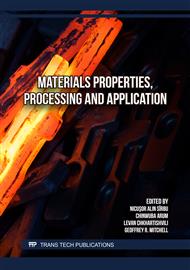[1]
S.G. Morozenko, B.E. Natapov, Effect of copper on the properties of steel R6M5, Met. Sci. Heat Treat. 32 (1990) 368-371.
DOI: 10.1007/bf00700047
Google Scholar
[2]
G. Fourlaris, A.J. Baker, Bainite formation in high carbon copper bearing steels, J. Phys. IV France C 7 (5) (1997) 389-394.
DOI: 10.1051/jp4:1997561
Google Scholar
[3]
A.M. Elwazri, A. Fatehi, J. Calvo, D. Bai, S. Yue, Analysis of copper effect on microstructures and mechanical properties in microalloyed steels, Iron Steel Inst. Japan Int. 48 (1) (2008) 107-113.
DOI: 10.2355/isijinternational.48.107
Google Scholar
[4]
E.J. Pavlina, S.-J. Lee, E.T. Virtanen, L.M. Rothleutner, Ch.J. van Tyne, Effects of copper on the hardenability of a medium-carbon steel, Metall. Mater. Trans. A 42 (2011) 3572-3576.
DOI: 10.1007/s11661-011-0906-6
Google Scholar
[5]
O.I. Sekunowo, S.I. Durowaye, O.P. Gbenebor, Effect of copper on microstructure and mechanical properties of construction steel, Int. J. Chem. Nucl. Metall. Mater. Eng. 8 (8) (2014) 785-789.
Google Scholar
[6]
A.A. Vnukov, Structure and properties of Fe–Cu–C system based sintered materials obtained using various alloying methods, Bull. Kharkiv Polytech. Inst. 49 (1158) (2015) 3-6. – in Russian
Google Scholar
[7]
V.I. Izotov, D.S. Ilyukhin, M.E. Getmanova, G.A. Filippov, Influence of copper on the structure and mechanical properties of pearlitic steels, Phys. Met. Metallog. 117 (6) (2016) 588-593.
DOI: 10.1134/s0031918x16040074
Google Scholar
[8]
T. Ogneva, N. Martyushev, I. Altpeter, M. Surkov, A. Tokarev, T. Krutskaya, Structure and properties of heat-treated medium-carbon steels alloyed with copper, Met. Working Mater. Sci. 20 (2) (2018) 130-143. – in Russian
DOI: 10.17212/1994-6309-2018-20.2-130-143
Google Scholar
[9]
P. Sellamuthu, P. Hodgson, N. Stanford, Effect of copper on microstructure, recrystallization and precipitation kinetics in strip cast low carbon steel, Mater. Res. Express 6 (2019) 1265j5 (1-20).
DOI: 10.1088/2053-1591/ab7310
Google Scholar
[10]
N. Saeidi, M. Raeissi, Promising effect of copper on the mechanical properties of transformation-induced plasticity steels, Mater. Sci. Technol. 35 (14) (2019) 1708-1716.
DOI: 10.1080/02670836.2019.1639889
Google Scholar
[11]
P. Maji, R.K. Bhogendro Meitei, S.K. Ghosh, Understanding the trends in welding of copper and steel, Univ. Porto J. Eng. 8 (6) (2022) 48-61.
Google Scholar
[12]
P. Salvetr, A. Gokhman, M. Svoboda, C. Donik, I. Podstranska, J. Kotous, Z. Novy, Effect of Cu alloying on mechanical properties of medium-C steel after long-time tempering at 500°C, Materials 16 (2023) 2390 (1-17).
DOI: 10.3390/ma16062390
Google Scholar
[13]
A. Huang, K. Wang, Y. Zhao, W. Wang, X. Wei, J. Peng, Effect of copper addition on the formability of 304L austenitic stainless steel, J. Mater. Eng. Perform. 32 (8) (2023) 3563-3570.
DOI: 10.1007/s11665-022-07367-2
Google Scholar
[14]
P. Lin, L. Wang, X. Liang, Q. Hu, L. Wang, Effects of copper infiltrant amount and infiltration method on mechanical properties of sintered steel, J. Phys. Conf. Ser. 2690 (2024) 012005(1-7).
DOI: 10.1088/1742-6596/2690/1/012005
Google Scholar
[15]
A.A. Gachechiladze, A.L. Oakley, B.G. Margiev, R.V. Chedia, L.S. Chkhartishvili, O.A. Tsagareishvili, Studying of process of obtaining nanocrystalline boron-containing alloys, Nano Studies 12 (2015) 205-208. – in Russian
DOI: 10.1016/b978-0-12-813351-4.00002-x
Google Scholar
[16]
A. Gachechiladze, B. Margiev, R. Chedia, A. Oakley, L. Chkhartishvili, O. Tsagareishvili, New nanoalloys for modifying the steel, in: J. Khantadze, L. Chkhartishvili, D. Ramazashvili, L. Tavadze (Eds.), Proc. 2nd Int. Conf. "Modern Technologies and Methods of Inorganic Materials Science", Sachino, Tbilisi, 2015, pp.228-231.
DOI: 10.1016/b978-0-12-813351-4.00002-x
Google Scholar
[17]
A. Oaklay, D. Macharadze, M. Ratishvili, B. Margiev, L. Chkhartishvili, Modification of chromium steel by nano-oxide composite, Proc. Georgian Natl. Acad. Sci. (Chem. Ser.) 42 (4) (2016) 516-519.
Google Scholar
[18]
A. Gachechiladze, A. Oakley, B. Margiev, O. Tsagareishvili, L. Chkhartishvili, M. Ratishvili, Some properties of nanoobjects and on modification of steel melts by nanocomposite, Nano Studies 13 (2016) 83-92.
Google Scholar
[19]
G. Zakharov, M. Chikhradze, D. Kvaskhvadze, N. Khidasheli, L. Chkhartishvili, G. Mikaberidze, S. Gvazava, Peculiarities of obtaining complex Fe–Mn–B ligatures by SHS-metallurgy technology using production wastes, ARPHA Proc. 7 (2024) 53-58.
DOI: 10.3897/ap.7.e0053
Google Scholar
[20]
T. Berikashvili, L. Chkhartishvili, A. Gigineishvili, Mechanism of ε-nanophase precipitation in copper-steel, in: L. Chkhartishvili, M. Chikhradze (Eds.), Abs. 7th Int. Conf. "Nanotechnology", Tech. Univ. Press, Tbilisi, 2024, pp.37-37.
Google Scholar


